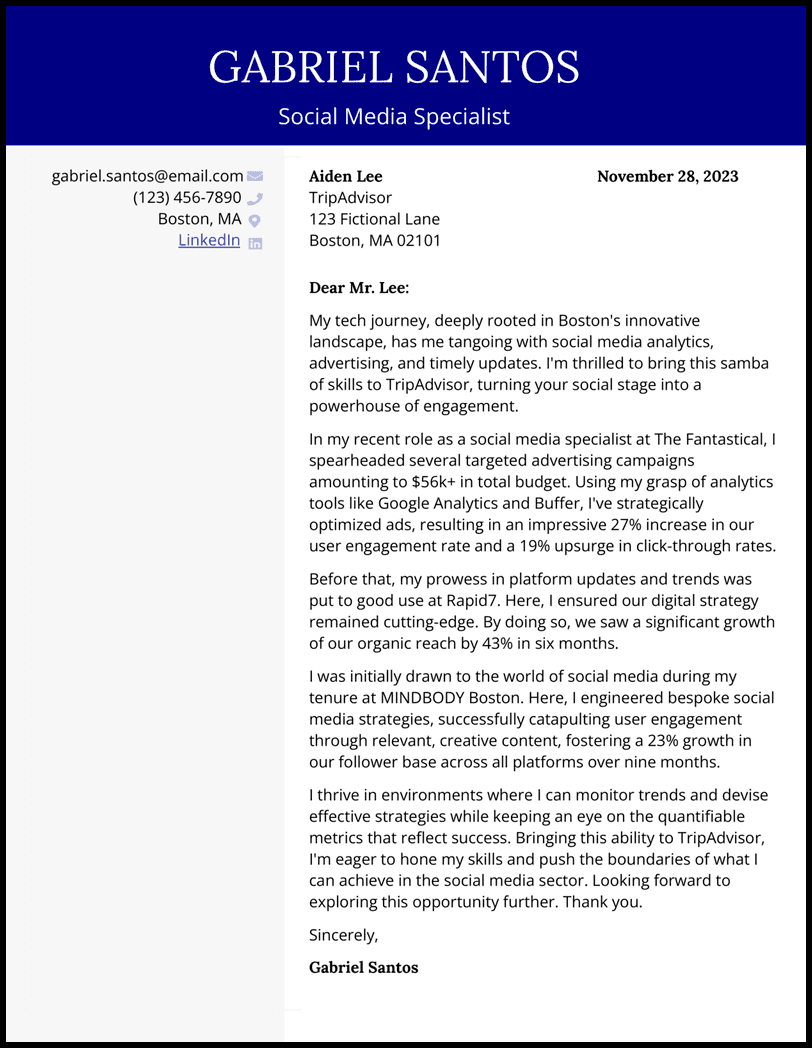You’re applying for a job and saw that you need to include a cover letter. Now you’re wondering, what is a cover letter? How do I structure it successfully?
We’re here to help you get the best results in the hiring process, from cover letter generators and templates to expert tips each step of the way.
This extensive guide will provide all the details on how to write a cover letter for 2026. That’ll include expert tips for today’s job market, cover letter examples, and how to structure it for different points in your career. By the end, you’ll have a clear vision and the tools to create an outstanding cover letter for any job you apply to.
What Is a Cover Letter?

The first question you might encounter is, what is a cover letter for a job? Before we get into the technical details of professional cover letters, let’s review the definition and overall purpose of one when hiring managers are reviewing applicants.

Definition and purpose
A cover letter is a formal business letter. It’s traditionally sent along with your resume when applying for jobs. The purpose of a cover letter is to introduce yourself to hiring managers while showcasing the skills and experiences you possess that make you right for the job.
Cover letters should be persuasive without feeling pushy. You should structure yours to show why an employer should hire you over other applicants, such as outlining your passion for the company’s mission and the critical skills or tactics you can apply to achieve it.
The cover letter can also be more personal and act as an extension of your resume. For instance, you could use it to explain a gap in your employment, why you’re ready to enter a field after just graduating college, or why you’re prepared to take on the responsibilities of a management role. When used correctly, it can be an essential tool to get the best results at any point in your career.

Importance of a cover letter
Many job seekers wonder: are cover letters necessary? The answer is yes. They are a crucial element that helps you land your dream job.
While you can use resume checkers, resume templates, or even a resume builder to ensure your top skills and experiences are properly represented on that all-important document, your resume isn’t always enough to differentiate you from every other candidate.
For example, consider the average job that receives hundreds of applications from professionals in that field looking for the right opportunity.
Now, the hiring manager narrows it down to you and a handful of other prospects they’re considering bringing in for an interview. All of you have a similar skill set and experience level on your resume.
Where do they differentiate between applicants? The cover letter.
You might be applying for a digital marketing job for a brand that sells home gym equipment. In your cover letter, you explain your passion for promoting healthier lifestyles and your desire to create dynamic social media campaigns that help sell the company’s products so others can use the equipment to improve their well-being.
That’ll stand out a lot more than applicants who submit generic cover letters or don’t display that same level of connection with the company’s mission and products. Suddenly, you look like the right person for the job and land that important interview.

Common myths about cover letters
While researching cover letters, you might encounter some common myths and misconceptions. To clear things up, let’s debunk those right now.
Myth #1:
Cover letters are outdated and unnecessary.
The reality: Cover letters aren’t outdated. 60% of jobs require cover letters, and 83% of hiring managers say they consider them during hiring decisions.
Myth #2:
You can copy and paste the same cover letter for every job.
The reality: To stand out, you must customize every cover letter based on the job description. 77.3% of employers say they want applicants to personalize cover letters since it’s an essential sign in the hiring process that they care about the company and are willing to go the extra mile.
Myth #3:
The cover letter is just meant to establish rapport and politeness.
The reality: Hiring managers want more than establishing polite rapport in your cover letter. They want to see why you want the job and your passion for the company. Don’t be afraid to include details about your interests and capabilities that make you stand out.Enter your text here…

Cover letter vs. resume
Both a resume and a cover letter serve an essential purpose in the hiring process, and they can work together to present a well-rounded overview of your abilities.
Your resume is a concise one-page document that provides an overview of the skills and experiences that make you right for the job. Typically, hiring managers review it to ensure you’re qualified for the role before moving you forward in the hiring process.
Your cover letter helps fill in the gaps and can be a bit more personal. It presents a thoughtful message about why you want the job, your connection to the company’s mission, and how you apply your skills to be a great addition to a company’s workplace. These details give hiring managers an idea of who you are as a candidate and how you’ll fit in with their company’s workplace culture.
How to Write the Perfect Cover Letter

Now that you know the purpose of a cover letter for a job, let’s review each step you should take while writing one. This section will outline the research you should do before you start, the proper structure for your cover letter, how to tailor the content to each job, and the mistakes to avoid.

Before you start
Before you begin writing a cover letter, it’s essential to research each employer and the job description. Here’s the information you should know before you start writing.
Research the employer
One of the first steps you should take is researching the employer. Try to figure out:
- What’s the company’s mission?
- What products or services do they provide?
- What’s their workplace culture?
This information about the company will help you tailor your cover letter to their needs and goals while showing how you’ll be a perfect fit for the workplace culture. Plus, these details will help you later in the hiring process when companies ask you questions like “Why do you want to work here?” during the interview.
Analyze the job description
It’s also essential to thoroughly review the job description. Most companies aim to provide a lot of details here so you can determine if you’re right for the job before applying. Try to find details like:
- The skills they’re seeking
- The tasks you will complete on the job
- Experience needed in the field
- Education level needed
These elements will help you decide what’s most important to include in your concise one-page cover letter. For example, if they put a big emphasis on education in the job description, you might want to include a paragraph highlighting your college degree and how it’s equipped you for the role.
These details will also help you optimize other aspects, like choosing the right resume skills to stand out.
Reflect on your experience and motivation
Your experience and career goals will also impact how you structure your cover letter.
Do you have any causes you’re passionate about? You could try to connect with companies that share the same mission.
For example, if you’re passionate about protecting the environment, you could look for companies that deploy environmentally friendly practices and mention that in your cover letter as a big reason why you want to work with them.
You could also consider your career goals and responsibilities you’re looking to take on.
Let’s say you just graduated college with an accounting degree and want to enter the tax sector. You could apply to companies where a key responsibility will be handling tax data and mention how it’ll be a perfect fit to apply your knowledge in income statements and tax reporting from college classes while continuing to grow your skills.

Structure of a cover letter
Now that you know the information you need, let’s review the proper structure for a cover letter. Knowing these details will help you create one from scratch or choose the ideal cover letter templates or outlines with all the necessary elements.
Header and contact information
Every cover letter should include a header with your contact information clearly listed. This will ensure hiring managers know how to get in touch with you to schedule an interview. It’s usually best to include your address, phone number, and email address to provide multiple ways to contact you.
The header should also include your full name and job title, the date, and the address of the company you’re applying to.
Greeting the hiring manager
It’s essential to greet the hiring manager by name whenever possible. It makes your cover letter sound more personal and specific to them rather than beginning with something generic like “Dear sir/madam.”
You can usually find the hiring manager’s name listed as a contact person in the job description, on the company’s website, or on company social media profiles.
If you’ve looked everywhere and can’t find the name of a contact person, the next best option is to begin with “Dear [Name of Company] Hiring Team.” This will still make it look personalized to the company.
Additionally, choosing a professional salutation is vital during the greeting. Usually, the safest choice for professional cover letters is to begin with “Dear” since it’s formal and time-tested to make a great impression.
Opening paragraph
During the opening paragraph of your cover letter, it’s essential to grab the hiring manager’s attention immediately. A great way to do so is by connecting with specific details about the company’s mission or a couple of top skills you possess that they’re seeking in the role to showcase how you’re the ideal fit.
Body of the letter
Once you get to the body paragraphs, elaborate on the abilities and passion you presented in the opening paragraph.
A great way to address this is by highlighting key achievements in past jobs with metrics showing your impact. Common metrics relevant to many roles include sales revenue generated, efficiency, or customer satisfaction rates.
When you’re an entry-level applicant, you can also highlight things like educational achievements or relevant volunteer work.
Closing paragraph
Knowing how to end a cover letter is as important as knowing how to open one. A strong closing paragraph will restate all the essential details you presented throughout the cover letter.
Reaffirm your passion for the company’s mission, restate your top skills, thank the hiring manager for their time, and end with a call to action stating you’re eager to take the next steps in the hiring process.
Additionally, after your closing paragraph, include a professional sign-off and sign with your full first and last name. The safest sign-offs for professional cover letters are “sincerely” or “thank you.”

Crafting compelling content
When you’re writing the content of your cover letter, there are specific elements you can add to make it stand out amongst other applicants. Let’s review each aspect so you can gather ideas for providing stellar examples and information in yours.
Highlighting your skills and experience
After reviewing the company’s information and the job description, you will understand its goals and the qualifications for the role. Try to choose examples of workplace achievements that are relevant to each company’s needs.
For example, someone applying to a customer service role that uses Zendesk might include an example of their success using that specific software to stand out.
Additionally, make sure you focus on achievements rather than just stating responsibilities in previous jobs. For instance, rather than just saying you were in charge of payroll processing, you could describe how you reorganized the payroll processing system to make it 35% more efficient.
Demonstrating cultural fit
While reviewing the job description, you’ll find several hints about the company’s culture.
For instance, a company might try to facilitate a collaborative workplace. Then, you could tailor your cover letter to show how you’re the ideal fit by showcasing examples of when you successfully collaborated with team members or describe your passion for working in team-focused workplaces.
Some other popular types of workplace cultures to look for in job descriptions are:
- Creative – Common in artistic or idea-driven fields
- Caring – Common in healthcare or customer-focused roles
- Safety-focused – Often present in manufacturing, transportation, construction, or other jobs using heavy machinery
- Purpose-driven – Typically seen in the non-profit sector or companies with a strong mission statement
- Results-oriented – Common in sales, managerial roles, or strategic roles
Whatever culture you’re presented with, try to tailor the examples you list and the tone of your letter to the job description to show how you’ll fit in.
Quantifying your successes
It’s important to use examples of workplace achievements with numbers that show your impact throughout your cover letter.
For example, rather than just saying you boosted sales, you can provide a bit more detail by saying you rewrote cold-calling scripts to boost conversion rates by 55% and subsequently increase sales by $345,000.
If you’re having a hard time finding numbers to add, consider different reports you’ve made in your role or common metrics your managers have emphasized in the past.
For instance, a therapist might feel that their results are more related to their patients’ quality of life, but there are still numbers they can use to quantify results, like patient satisfaction or referral rates.
Tailoring for specific roles
Every role has varying responsibilities, so it’s important to tailor your cover letter to each one. Even if the jobs have the same title, each company may use different software, have a different managerial hierarchy, or use varying reporting processes.
For example, one school hiring teachers might want employees who focus on group projects, whereas another wants the teaching staff to use personalized learning techniques, so you’d want to tailor your cover letter to the needs of each school.
Applicants who customize their cover letters to individual needs will have a better chance of appearing as the right fit and landing an interview, so it’s always beneficial to take a little extra time to do so.

Common mistakes to avoid
Before you submit your cover letter, take some time to review it. Let’s review some common mistakes applicants make and how to avoid them.
Using generic phrases
Try to avoid generic phrases or using clichés in your cover letter. This is usually a sign that you didn’t take enough time to customize the details to the job’s needs. Some examples of clichés in cover letters are:
- I’m a people person
- I think outside the box
- I’m a team player
- I’m motivated
Instead of saying phrases like these, try to get more specific. For instance, rather than saying you’re a people person, use specific customer service skills or achievements, such as your proficiency in solution-focused customer service principles and how you’ve maintained 98% positive satisfaction rates in previous roles.
Focusing too much on yourself
While you should showcase your skills and experiences, the real focus should be on how you will benefit the company and fit its culture. Always try to think from that lens and get specific to each company’s needs to show how you will help them.
Overlooking Proofreading
One of the biggest mistakes that can ruin an otherwise great applicant’s chances is spelling and grammar mistakes throughout a cover letter. Always proofread before submitting it to ensure you make the best first impression on hiring managers. To help with this, you can use grammar checkers or have a trusted friend or colleague review it for you.
Ignoring instructions
Another reason you should thoroughly review every job description is that it might contain essential instructions for submitting your application. For instance, some companies might want you to email your cover letter and include a specific subject line. Failing to do so could result in never getting considered for the job.
Examples of Cover Letters

How you structure your cover letter can vary depending on where you are in your career and the position you’re applying to. Here are some example cover letters that are helping job seekers get hired in today’s job market.

Entry-level cover letter examples
Entry-level applicants are in a unique position since they likely have little to no experience in the field they’re applying to. That said, whether you’re a recent college grad or a high school student seeking your first job, you still have plenty of ways to show you’re the right fit for the role.
Some ways entry-level job seekers can show their capabilities in cover letters are:
- Presenting applicable knowledge and achievements from school
- Using non-traditional work experience from volunteering or school clubs
- Showcasing transferable skills from other fields
Here are some great examples of entry-level cover letters:
Why this cover letter works
- Navigating the realm of childcare without relevant professional experience can seem like diving into a mysterious land without a compass. But worry less, for a memorable experience involving nurturing kids can go a long way to steer your candidacy forward.
- Perhaps it was one priceless moment when you mentored kids while volunteering locally or were assigned a camp counselor role during Red Cross Training. Use such moments to illuminate your childcare no-experience cover letter.
Why this cover letter works
- Even at the early stages of your career, a notable achievement at college or during a previous internship can set your electrical engineer apprenticeship cover letter apart from tens of other similar pieces.
- Did you propose a solution to a technical error in a project design, saving the company you were interning for time and money? Or perhaps you designed an energy efficiency system for your campus. Whichever your case, use it to showcase your dependability in real work situations.
Why this cover letter works
- With limited formal experience, let your waitress no experience cover letter brim with enthusiasm for the industry and the hiring establishment while showcasing a proven record of fostering tangible results. Reflect on the value contributed during past internships and volunteer work.
- Transferable skills from other hospitality roles can propel your candidacy ahead of the competitors. An example is the multilingual prowess honed from engaging guests in Waikiki Beach.

Mid-career cover letter examples
As you advance into mid-career roles, you should have significant experience you can now portray on your cover letter. This should include specific examples of workplace achievements with numbers for the impact you had throughout your body paragraphs.
To ensure your cover letter remains concise and stays on a single page, you can remove less relevant details about your education, non-traditional work, or jobs in other fields that you may have included in entry-level cover letters.
Here are some great examples to show how you can structure yours effectively:
Case Management Cover Letter Example
Copy this for your case management cover letter!
123 Fictional Avenue
Oklahoma City, OK 73101
(123) 456-7890
October 30, 20XX
Sofia Allen
Oklahoma City Indian Clinic
123 Fictional Lane
Oklahoma City, OK 73101
Dear Ms. Allen:
The story of a resilient patient who successfully managed her complex health issues resurfaced in my memory when I discovered the healthcare case manager position at Oklahoma City Indian Clinic. With a deep sense of empathy and a commitment to patient-centric healthcare, I know I can utilize my skills in Electronic Health Records (EHR) management, care planning, and coordination.
In my previous role with Health Watch Clinic, my adept knowledge of EHR Management using Epic Systems software facilitated a 27% increase in operational efficiency. The results were multi-layered—healthcare providers experienced significant time savings, and patients, thanks to quicker access to critical information, enjoyed an enriched healthcare experience.
A stint at OU Health University of Oklahoma Medical Center solidified my care planning and coordination expertise. I capitalized on cutting-edge digital tools and meticulously designed care plans, which resulted in a 22% reduction in patient readmission rates and a gratifying 38% boost in patient satisfaction scores.
Furthermore, my understanding of healthcare regulations and compliance, kindled through continuous training and vigilance with legislative updates at Integris Health, culminated in a 36% hike in policy compliance. Through timely awareness sessions and holding informative meetings, I ensured the teams remained updated and met high compliance and patient safety standards.
Equipped with a wide-ranging professional background and an unwavering commitment to optimizing patient well-being, I’m eager to engage in a deeper conversation about how my professional repertoire as a healthcare case manager can support your clinic’s mission. Enclosed with this cover letter is my Case Manager Certification, a testament to my knowledge and capabilities in this field. I look forward to hearing from you soon. Thank you.
Sincerely,
Leo Costa
Enclosures:
Resume
Application
2 letters of recommendation
Case Manager Certification
Why this cover letter works
- Strategically aligning an unforgettable experience of a patient’s recovery with your interest in the role is one of the several ways of bringing your case management cover letter to life. This is thanks to a touch of humanity, a quality critical for this role.
- For example, recount helping a particular patient in their recovery journey, subtly showcasing your dedication to patient care. The connection is best done in the introductory paragraph for instant connection.
Why this cover letter works
- When writing a front-end developer cover letter, picture yourself as a gifted storyteller, framing your past professional narratives as invaluable lessons that have prepared you for the role you are eyeing.
- Suppose one paragraph narrates your experience at a startup where you mastered frameworks like React and Angular under intense software development cycles. Dedicating a line at the end to how the technical expertise and discipline acquired here will help you ace the open position.

Cover letters for a career change
While going through a career change, presenting skills in a field you haven’t worked in before can feel challenging. However, if you have significant experience in another field, you can still find ways to show how your abilities will transfer to a new role.
For example, many roles require customer service or efficient data management, so you could connect abilities like those in your cover letter whenever possible.
Additionally, if you’ve pursued further education in the new field you’re entering, you could discuss how your studies have equipped you for the role.
Here are a couple of top-notch examples to show you how to structure this appropriately:
Why this cover letter works
- Let’s assume you’re an HR expert eyeing a bank management position. Your ability to adapt and guide change can be a monumental highlight in your human resources career change cover letter. That can be highlighted through an example or two, like how Zara oversees technological enhancements at her former bank.
- Such competencies demonstrate that although it’s a career change, you aren’t a stranger to the environment. If the past stints involved the hiring company’s competitor, emphasize that for bonus familiarity points.
Why this cover letter works
- Some career moves are bigger leaps than others. Transitioning from healthcare to sales is one of them. This RN career change cover letter identifies unexpected parallels between nursing and closing deals.
- Look for unlikely connections between your work experience and target role, then put the pieces together in your cover letter to present to recruiters.

Cover letters for remote jobs
When you’re applying to remote jobs, they often come with unique responsibilities and reporting needs to be successful in the role. Therefore, you should tailor your cover letter accordingly to ensure you stand out and reassure hiring managers of your capabilities to work in a more self-managed environment.
One essential detail you might need to consider is the software or programs you’ll use on the job. For instance, if the job requires attending virtual team meetings, you might need to present proficiency in programs like Zoom or Microsoft Teams. You might also communicate a lot through email, so emphasizing skills in email correspondence can be great to include, too.
Here is a cover letter for remote jobs that did a terrific job emphasizing the applicant’s capabilities in a virtual work environment:
Why this cover letter works
- Got some virtual assistant proficiencies up your sleeve? It’s time to bring those capabilities, including expertise in office tasks, digital marketing, and technological prowess, to light.
- The more you align your skills with the job ad, the sparkier your virtual assistant cover letter becomes. But don’t highlight these proficiencies casually. Weave them into compelling narratives of you overcoming challenges, spurring efficiency, and achieving positive results (cue increase in LinkedIn and Instagram followers)
Here are a couple of other examples that aren’t specifically tailored to remote work, but could work well if they were adjusted slightly.
Why this cover letter works
- No doubt, your social media specialist cover letter has a bagful of social media proficiencies, but the hiring manager wants to witness the magic you orchestrated at your past job.
- The catch here is to concretize your professional accomplishments and your potential value in quantifiable terms. That could range from amplified click-through rates to a significant rise in follower counts. Who knows, that paragraph about boosting organic traffic by 27% might have the potential employer envisioning you replicating such success in their company.
Why this cover letter works
- Sometimes, stepping outside the norm is when the magic happens. It could be as simple as weaving in an industry-relevant statistic, as Adrian’s cyber security analyst cover letter gives the reader insight into the percentage of local businesses that fall prey to cyber-attacks.
- Statistics indicate your ability to turn data into a relevant story. More importantly, it shows you understand the industry’s trajectory and the opportunities that lay in wait.
How to Write a Cover Letter FAQs

One of the biggest things to avoid in cover letters is negative statements about previous jobs or managers. Instead, reflect positively on the opportunity to work with each company you’re applying to, what you’ve gained from previous experiences, and excitement about future outcomes. Also, avoid grammatical errors, irrelevant information, generic phrases, or salary expectations.
Typically, a hiring manager from the company’s HR or recruiting department will review cover letters and applications. That’s why you should address the hiring manager by name in the greeting. Otherwise, some companies might have a full hiring or recruiting team that collectively works to review applicants.
Even if a job opening lists the cover letter as optional, you should always submit one. It’ll give you a better opportunity to stand out and make a great first impression on the hiring manager, showing how you relate to the company’s mission, your top skills, and why you’re interested in the opportunity.
A cover letter and an introduction statement have slightly different goals. An introduction statement showcases your qualifications and requests that you be considered for future roles. A cover letter is a formal business letter submitted for a current job opening to show why your skills and qualifications match that specific job.
Limit your cover letter to a single page using 11 or 12-point font. It should be about 250-400 words in total. Hiring managers have many applications to review, so keeping it concise with the most relevant information will help them easily identify your top skills during quick analysis.
You should avoid copying and pasting the exact same cover letter for every job you apply to. You can use a cover letter template or outline to maintain a professional structure, but customize the skills and achievements you include based on the details of each job description.













